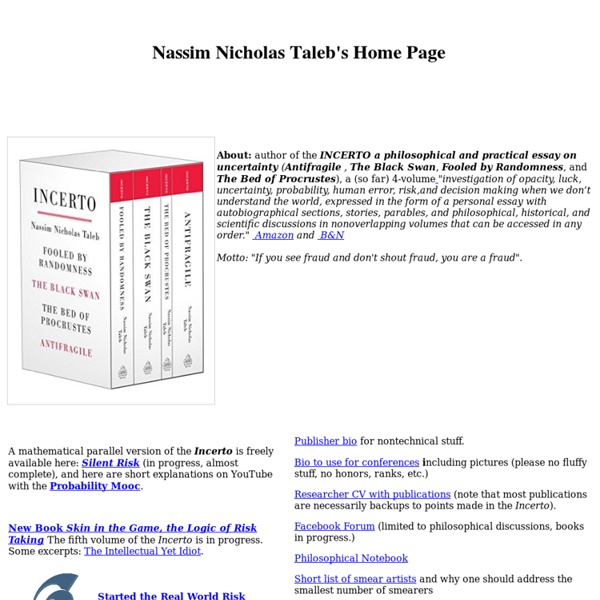Praise versus Encouragement
Most of us believe that we need to praise our children more. However, there is some controversy regarding this point. If we always reward a child with praise after a task is completed, then the child comes to expect it. However, if praise is not forthcoming, then its absence may be interpreted by the child as failure. According to Naomi Aldort, "Children who are subjected to endless commentary, acknowledgment, and praise eventually learn to do things not for their own sake, but to please others." But the avoidance of all praise is not a solution either.
10 Reasons Creative Folks Make Us Crazy
July 31, 2006 Liz published this at 10:33 am As Business Looks for Creative Thinkers — Look Out! In this age of innovation, Business Schools look to fill theirs eats with more right brain creative people. Folks are beginning to take notice of the value and power of the off the wall idea. Business Week.com devotes an entire section to innovation and creativity and companies have titles such as Idea Czar on their organizational chart.
Porter five forces analysis
A graphical representation of Porter's five forces Porter's five forces include - three forces from 'horizontal' competition: the threat of substitute products or services, the threat of established rivals, and the threat of new entrants; and two forces from 'vertical' competition: the bargaining power of suppliers and the bargaining power of customers. Porter developed his Five Forces analysis in reaction to the then-popular SWOT analysis, which he found unrigorous and ad hoc.[1] Porter's five forces is based on the Structure-Conduct-Performance paradigm in industrial organizational economics.
How 30 Minutes a Day Can Increase Your Intelligence
If you ask me, where humans go wrong is with their lack of patience. That, and their recent acquired taste for instant gratification. The reality is that things take time.
DAISY, DAISY, GIVE ME YOUR ANSWER DO...
In 1892, by which time the bicycle was an everyday sight in Victorian life, Henry Dacre composed a song that became immensely popular, both in the London music halls and in America. The lyrics featured a tandem - a bicycle made for two - and the Daisy he described was said to be based on the Countess of Warwick, Frances Evelyn 'Daisy' Greville. Daisy was a champion of women's rights, and also a mistress of the Prince of Wales, and her name is still well-known today from the chorus of Dacre's 'Daisy Bell' - Daisy Daisy, Give me your answer do! I'm half crazy, All for the love of you! It won't be a stylish marriage, I can't afford a carriage, But you'll look sweet on the seat Of a bicycle built for two !
Peter H. Diamandis
Dr. Peter H. Diamandis is an international pioneer in the fields of innovation, incentive competitions and commercial space. In the field of Innovation, Diamandis is Chairman and CEO of the X PRIZE Foundation, best known for its $10 million Ansari X PRIZE for private spaceflight. Today the X PRIZE leads the world in designing and operating large-scale global competitions to solve market failures. Diamandis is also the Co-Founder and Vice-Chairman of Human Longevity Inc.
Formula for success in learning
If you have found this place in the vast cyberspace of the web, you are probably not the one to convince that knowledge is power, and that solutions to most problems facing humanity could be found if we were armed with more understanding of how the world works. While knowledge is power, information can be overpowering. An increasing proportion of the population suffers from Information Fatigue Syndrome, i.e. from stress related to being overwhelmed with an unmanageable glut of information. This text introduces you to simple steps toward managing information and toward rock-solid knowledge. No cheap miracles.
The Bulletproof Executive: Press Room - Bulletproof
Featured In Trending What People Are Saying Get Connected Print Bloomberg Business – Buttered Coffee Could Make You Invincible.
The Science of “Chunking,” Working Memory, and How Pattern Recognition Fuels Creativity
by Maria Popova “Generating interesting connections between disparate subjects is what makes art so fascinating to create and to view… We are forced to contemplate a new, higher pattern that binds lower ones together.” It seems to be the season for fascinating meditations on consciousness, exploring such questions as what happens while we sleep, how complex cognition evolved, and why the world exists. Joining them and prior explorations of what it means to be human is The Ravenous Brain: How the New Science of Consciousness Explains Our Insatiable Search for Meaning (public library) by Cambridge neuroscientist Daniel Bor in which, among other things, he sheds light on how our species’ penchant for pattern-recognition is essential to consciousness and our entire experience of life. To illustrate the power of chunking, Bor gives an astounding example of how one man was able to use this mental mechanism in greatly expanding the capacity of his working memory.



